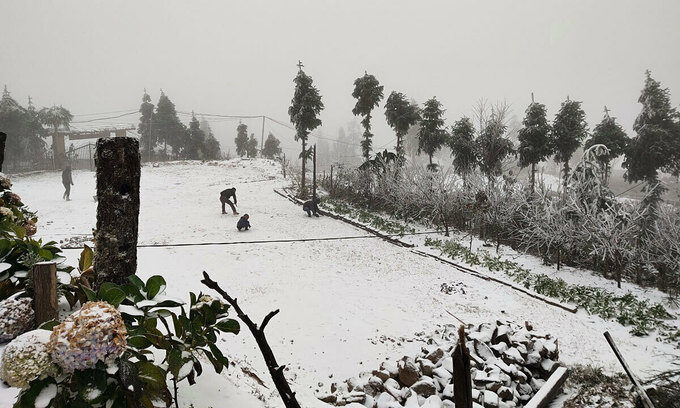
Due to drizzles at low temperature, snow has covered O Quy Ho mountain pass in Lai Chau Province and Sa Pa, a popular tourist town in Lao Cai Province, since Sunday night.
At a height of 1,500 meters above sea level, Sa Pa has recorded temperatures dropping to minus one degree Celsius on Monday and in Sin Ho mountainous district of Lai Chau, to minus two degrees Celsius.
Temperatures on Mau Son Mount of Lang Son Province have risen by one to two degrees Celsius against prior days to 0.5 degrees Celsius and in Dong Van Town in Ha Giang, to two degrees Celsius.
The northern region has entered the fifth day of a cold snap resulting from a strong cold front, expected to last until Wednesday.
Pham Ngoc Tuan, a resident in O Quy Ho, said snow started falling more heavily Monday morning, forming a 1-3 centimeter layer from the middle of the pass to its top.
Living in Y Ty Commune of Lao Cai's Bat Xat District, Phu Suy Tho said snow started falling from 1 a.m. Monday, culminating in a layer of seven to 10 centimeters.
Over the past days, many tourists have been flocking to northern mountainous regions like Sa Pa, Y Ty and O Quy Ho to admire the unusual bout of frost and snow.
Vietnam typically encounters a tropical climate with annual average temperatures ranging from 22 to 27 degrees Celsius.
But the northern highlands have received frost and snow every winter in recent years.
According to the National Center for Hydro-Meteorological Forecasting, the northern region would switch to dry cold weather from Tuesday.
American forecasting services provider AccuWeather said the lowest temperatures in Hanoi would hit 10 degrees Celsius on Tuesday and rise to 14 on Saturday. Temperatures in Sa Pa on Tuesday would be two to seven degrees Celsius, and seven to 14 degrees Celsius over the weekend.
Vietnam has experienced a colder winter than usual this year as the Pacific Ocean sea surface temperature drops, forming the La Niña phenomenon, weather experts said. The country should expect up to 27 waves of cold air coming from the north this winter, a typical average.



Reader Comments
to our Newsletter